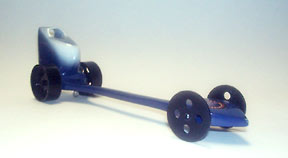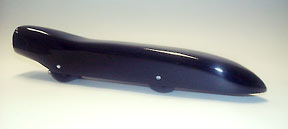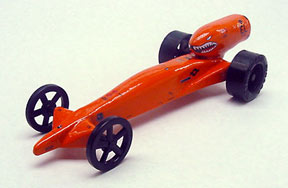
Rail Car
Cars
| Home | CO2 Racing | Cars | Physics of CO2 Racing | Making your own CO2 Car |
Your basic CO2 car is simply an 8 x 1.5 x 4 inch block of wood which is then shaped to be as smooth and aerodynamic as possible.
Most cars have exterior wheels (Wheels placed outside the car's body) but some have interior wheels which reduces friction and adds
speed. For thrust, a single CO2 canister fits in a 3/4 inch wide hole in the back of the car. The canisters typically hold 6 cubic
ounces of carbon dioxide, but the CO2 gas can be compressed up to seventy thousand psi. This however, creates no danger for the
builder since most canisters are 1/16 inches of refined steel. The front axels are usually smaller in comparison to the rear
wheels because the weight is usually lesser in the front. To add the axels, two holes must be drilled and the wheels can fit right
onto a metal pin which then can go through the hole. The pin used is placed inside a straw which is also placed inside the axel
hole. The straw provides a bearing and adds lubrication. Brass washers are normally used to separate the wheels from the body and add
lubrication.

Rail Car

Shell Car

Normal Car
| Home | CO2 Racing | Cars | Physics of CO2 Racing | Making your own CO2 Car |